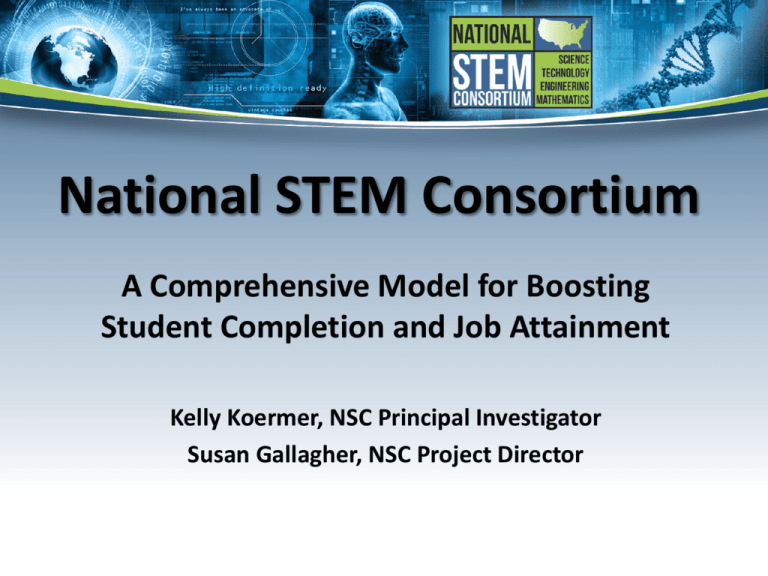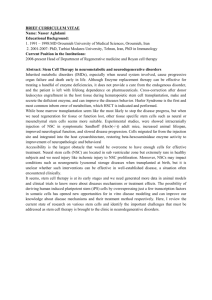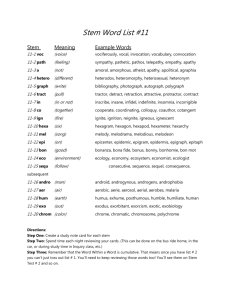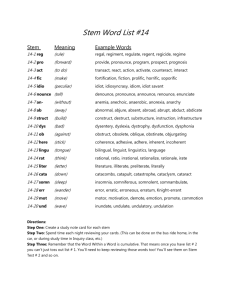AACC SP15_GallagherKoermer 041015
advertisement

National STEM Consortium A Comprehensive Model for Boosting Student Completion and Job Attainment Kelly Koermer, NSC Principal Investigator Susan Gallagher, NSC Project Director What is the National STEM Consortium? Anne Arundel Community College in Maryland College of Lake County in Illinois Clover Park Technical College in Washington State Cuyahoga Community College in Ohio Florida State College at Jacksonville Ivy Tech Community College in Indiana Macomb Community College in Michigan Northwest Arkansas Community College Roane State Community College in Tennessee South Seattle Community College in Washington State What is the Role of the NSC? Design and deliver Science, Technology, Engineering, and Mathematics (STEM) programs: • Nationally portable • High-quality certificate-level • Responsive to labor market needs • Embed contextualized remediation – “STEM Bridge” • Build a national model for multi-college cooperation One Year STEM Certificates Mechatronics Technology Environmental Technology Electric Vehicle Technology Cyber Technology Composites Technology Partners • • • • Public workforce agencies • Identify industry trends • Refer candidates; placement Employers • Identify industry needs – learning outcomes • Provide input on curricula • Hire our completers! Community colleges • Prepare curricula • Identify “bridge” components OLI, CAST What do Employers Need? Need – Employers • Pipeline of qualified new workers for immediate and future openings • • • • Hands-on skills Industry credentials Essential core skills Linked to industry-vetted KSAs Upskill incumbent workers to fill key positions • Fast, fluid and flexible • What do Students Need? Need - Students • A stable career pathway • • • • Family-sustaining wages Marketable skills Industry certifications Academic Credential • • • Accelerated time to completion Higher likelihood of successful completion Affordable What Do Community Colleges Need? Need - Colleges • Innovative approaches to teaching and learning in response to emerging academic challenges • • • • Declining enrollments Declining student retention and completion Declining budgets and resource availability Proven methods to accelerate completion and meet immediate employer needs • • Address developmental academic needs Program and student success (completion, retention, job placement) • • Student and faculty support to promote student success Reputation for excellence and innovation The Value Proposition What if Community Colleges could quickly prepare students for high demand employment opportunities in programs with completion rates of 69% , and a 69% rate of employment? A Comprehensive Model NSC Treatment Model Composites YElectric Vehicle Mechatronics STEM Bridge Cyber Environmental NSC Treatment Model • • • • • Technical curricula STEM Bridge curricula: embedded, contextualized remediation Cohort enrollment Block scheduling Embedded student supports: navigation services NSC Technical Curricula • 30+ Credits per pathway • All course materials available as an Open Educational Resource on Platform+ > • Additional interactive “sticking points” • Comprehensive Program Guides providing information on all aspects of program adoption *Conversion to OER in progress: to be completed by 5/30/15 Comprehensive Program Materials Employer Outcome Driven Programs Curriculum Hosted on OLI Five STEM Certificate Programs Program Guides NSC Curriculum STEM Bridge Courses NSC OER Available On OLI Spring 2015 Program Guide Course Syllabus Lesson Plans Toolkit Instructional Materials Labs Program Guides For each program, the Guide Provides: • Overview of the Industry • Description of the Certificate Program • Program Infrastructure • How to Adopt the Program • The Role of Employers • Student Success Strategies • Sustainability • Boosting Job Placement Course Materials For each course in every program: • • • • • • • • • • Instructor Toolkit Syllabus Lesson Plans Labs Quizzes/Assessments Handouts PowerPoints Links to External Materials (including industry content) Images Videos “Sticking Points”/Mini-Lessons “Sticking Point”: Known troublesome concept for students, difficult concept to learn Solution • Online mini-lesson (module) designed to reinforce and remediate these topics • Self-paced • Completed as homework and/or instructor led Two Modules/Mini-Lessons (Sticking Points) Per Course STEM Bridge STEM Bridge is a two-part strategy to provide support to learners in the STEM certificate programs. Certificate Ready: “STEM Readiness” Course Embedded, contextualized, online course to quickly refreshes key skills in math, communications, critical thinking and professional skills. Lower-Level Learners: “STEM Foundations” Course Modularized set of curriculum “bundles” that can be adapted and inserted as needed to support foundational skills in Math and Workplace Communication before entering the credit certificates STEM Readiness Curriculum Math • • • • • • • Placement Test Arithmetic Measuring Systems Charts and Graphs Basic Algebra Triangle Geometry Cartesian Plane 15 hours Critical Thinking & Workplace Communication • • • • Summarizing Oral & Written Communication After-Action Reporting Troubleshooting 15 hours Professional Skills • • • • • • • • Customer Service Confidentiality Organizational Skills Time Management Teamwork Resume Writing Cover Letters Interviewing 15 hours STEM Foundations Curriculum Workplace Communications Math • • • • • • The Number Line and Integers Multiplying and Dividing Integers Order of Operations (MDAS) Fractions Conceptual Equality Signed/Negative Values • Reading Strategies for Comprehension • Writing Skills • Writing Structure • Listening and Speaking Skills • Time Management 12-15 Hours Total Instruction Time OER Content • STEM Bridge Content – Fully Available and Free: • Open Learning Initiative (OLI) website: http://oli.cmu.edu Sign Up on main page • STEM Readiness use Course Key: ALL-STEM4 • STEM Foundations use Course Key: STEMBASIC2 • • Technical Content – available by 5/30/15 • http://tinyurl.com/NationalSTEM • Sign up to receive a notification when content is available What are the Benefits To Employers? Benefits: Employers • Pipeline of qualified workers • • decreased training costs decreased job vacancy time Access to credentialed workers with relevant handson skills • Enables employer to establish and support career ladders • Well-prepared workers enhance revenue through increased quality, efficiency and volume • Training available for employers to use for OJT • What are the Benefits To Students? Benefits: Students • • • • • • Prepares students for higher paid jobs Gets students to work more quickly Increases students’ success mindset and confidence Decreased frustration levels and drop-out rates Allows students to work and/or handle other personal responsibilities while quickly completing credentials Enables student access to technical curricula without delay of developmental prerequisites A Student’s Perspective • https://www.\youtube.com/watch?v=uMG34JCDsAA What are the Benefits to Colleges? Benefits: Colleges • • • • • • • • • • • • • Increased revenues through tuition and fees Increased state funding in performance/completion-based funding Credibility with employers Enhanced reputation and job outcomes result in increased enrollments High-quality, effective curricula, modifiable and customizable to additional programs Saves time and resources through use of NSC OER Reduces time to completion Increased number of academic certificates and industry credentials earned in support of completion agenda Content and approach can be adapted for entrepreneurial activities Collaborative process can be replicated for other grants and projects Successful project enhances competitive advantage Collaboration reduces costs because tasks are shared among institutions Collaboration increases value, efficacy and richness of product Return on Investment Retention ROI: 100 Students in a 30 Credit Program, College Earns $167,289 MORE Using NSC Model Competition/Barriers • • • • • • • • • Faculty resistance Cost/resources to scale and sustain within our own institutions Proprietary training institutions Existing less-successful developmental curricula Available virtual advising systems Other institutions of higher education Our own institutions - resistance against change Employer in-house training Block scheduling and cohort enrollment is inconvenient to implement and manage alongside traditional scheduling and offerings National STEM Consortium Resources NSC Website: www.NationalSTEM.org • Facebook: • • • • https://www.facebook.com/AACCMechatronics https://www.facebook.com/MCCEVCert PBS Feature: http://www.pbs.org/wnet/need-toknow/economy/certifiably-employable/16901/ • Pathway videos: • • • • • Mechatronics: http://www.youtube.com/watch?v=tBqkQ_pRm54&feature=youtu.be Cyber: http://www.nwacc.edu/web/stem/cyber-technician-certificate Composites: https://www.youtube.com/watch?v=6KA9ZzcewX0 Electric Vehicle Development: http://www.youtube.com/watch?v=VMO0unlzGCE Electric Vehicle Repair: http://www.youtube.com/watch?v=UW2ZY94lO0w National STEM Consortium Resources • NSC Website: www.NationalSTEM.org • NSC Policies and Sample NSC Curriculum Documents • Available via Dropbox: • https://www.dropbox.com/sh/sru3t4iz8dyds04/rHfmhJunz4 • STEM Bridge Access: Open Learning Initiative (OLI) website: http://oli.cmu.edu Sign Up on main page • STEM Readiness use Course Key: ALL-STEM4 • STEM Foundations use Course Key: STEMBASIC2 • National STEM Consortium Content Availability Complete this electronic form to be notified of National STEM Consortium curriculum content availability: http://tinyurl.com/NationalSTEM • • • Composite Materials Technology Cyber Technology Electric Vehicle Development and Repair • • • Environmental Technology Mechatronics STEM Bridge (math, communications and professional skills) Questions? Susan Gallagher NSC Project Director sgallagher@aacc.edu 410-777-2124 Kim Law NSC Cyber Technology Coordinator kplaw@aacc.edu 410-777-2387 Kelly Koermer NSC Principal Investigator kkoermer@aacc.edu 410-777-7432 AACC is an equal opportunity, affirmative action, Title IX, ADA Title 504 compliant institution. Call Disability Support Services, 410-777-2306 or Maryland Relay 711, 72 hours in advance to request most accommodations. Requests for sign language interpreters, alternative format books or assistive technology require 30 days’ notice. For information on AACC’s compliance and complaints concerning discrimination or harassment, contact Kelly Koermer, J.D., federal compliance officer, at 410-777-2607 or Maryland Relay 711. This workforce solution was funded by a grant awarded by the U.S. Department of Labor’s Employment and Training Administration. The solution was created by the grantee and does not necessarily reflect the official position of the U.S. Department of Labor. The Department of Labor makes no guarantees, warrantees, or assurances of any kind, express or implied, with respect to such information, including any information on linked sites and including, but not limited to, accuracy of the information or its completeness, timeliness, usefulness, adequacy, continued availability, or ownership.





